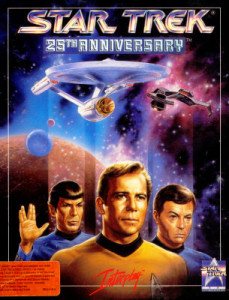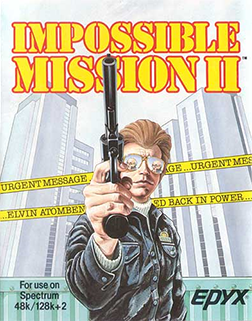
Star Trek: 25th Anniversary is an adventure video game developed and published by Interplay Productions in 1992, based on the Star Trek universe. The game chronicles various missions of James T. Kirk and his crew of the USS Enterprise. Its 1993 sequel, Star Trek: Judgment Rites, continues and concludes this two-game series.

UFO: Enemy Unknown, also known as X-COM: UFO Defense in North America, is a 1994 science fiction strategy video game developed by Mythos Games and MicroProse. It was published by MicroProse for DOS and Amiga computers, the Amiga CD32 console, and the PlayStation. Originally planned by Julian Gollop as a sequel to Mythos Games' 1988 Laser Squad, the game mixes real-time management simulation with turn-based tactics. The player takes the role of commander of X-COM – an international paramilitary and scientific organization secretly defending Earth from an alien invasion. Through the game, the player is tasked with issuing orders to individual X-COM troops in a series of turn-based tactical missions. At strategic scale, the player directs the research and development of new technologies, builds and expands X-COM's bases, manages the organization's finances and personnel, and monitors and responds to UFO activity.

Space Hulk is a 1993 real-time tactical video game for MS-DOS, Amiga and PC-98. The game was based on Games Workshop's 1989 board game of the same name. Set in the fictional Warhammer 40,000 universe, the player directs squads of Space Marines, genetically enhanced armoured soldiers, in their missions to protect the human race from deadly aliens. Space Hulk was developed and published by Electronic Arts, with support from Games Workshop.

F-19 Stealth Fighter is a combat flight simulator developed and released in 1988 and 1990 by MicroProse, featuring a fictional United States military aircraft. It is the 16-bit remake of the 8-bit game Project Stealth Fighter, which was released for the Commodore 64 in 1987. It was also ported to the NEC PC-9801 in Japan only, and the DOS version was re-released on Steam distribution platform in 2015.

Syndicate is an isometric real-time tactical and strategic game from Bullfrog Productions created in 1993, and released for a variety of platforms beginning with the PC and Commodore Amiga. It is the first title in the Syndicate series. Set in a dystopian future in which corporations have replaced governments, Syndicate puts the player in control of a corporation vying for global dominance.

Sid Meier's Covert Action is an action and strategy video game released in 1990 by MicroProse for IBM PC compatibles and Amiga. The player takes the role of Maximillian Remington, a skilled and deadly free agent hired by Central Intelligence Agency, investigating on-going criminal and terrorist activities. Tommo purchased the rights to this game and digitally publishes it through its Retroism brand in 2015.

Laser Squad is a turn-based tactics video game, originally released for the ZX Spectrum and later for the Commodore 64, Amstrad CPC, MSX, Amiga, Sharp MZ-800 and Atari ST and PC computers between 1988 and 1992. It was designed by Julian Gollop and his team at Target Games and published by Blade Software, expanding on the ideas applied in their earlier Rebelstar series. Laser Squad originally came with five mission scenarios, with an expansion pack released for the 8-bit versions, containing a further two scenarios.

Stationfall is an interactive fiction game written by Steve Meretzky and released by Infocom in 1987. It was published for the Commodore 64, Amiga, Amstrad CPC, Apple II, Atari 8-bit computers, Atari ST, and MS-DOS. The game is a sequel to Planetfall, one of Infocom's most popular games. It is Infocom's twenty-fifth game.
The Bureau for State Security was the main South African state intelligence agency from 1969 to 1980. A high-budget and secretive institution, it reported directly to the Prime Minister on its broad national security mandate. Under this mandate, it was at the centre of the Apartheid state's domestic intelligence and foreign intelligence activities, including counterinsurgency efforts both inside South Africa and in neighbouring countries. Like other appendages of the Apartheid security forces, it has been implicated in human rights violations, political repression, and extra-judicial killings.

Impossible Mission II is a video game developed by Novotrade and published by Epyx in 1988. It was released for the Commodore 64, ZX Spectrum, Amstrad CPC, Enterprise 128, Nintendo Entertainment System, DOS, Atari ST, Apple II with at least 128K, Apple IIGS, and Amiga.

I Have No Mouth, and I Must Scream is a 1995 point-and-click adventure horror game developed by Cyberdreams and The Dreamers Guild, co-designed by Harlan Ellison, published by Cyberdreams and distributed by MGM Interactive. The game is based on Ellison's short story of the same title. It takes place in a dystopian world where a mastermind artificial intelligence named "AM" has destroyed all of humanity except for five people, whom he has been keeping alive and torturing for the past 109 years by constructing metaphorical adventures based on each character's fatal flaws. The player interacts with the game by making decisions through ethical dilemmas that deal with issues such as insanity, rape, paranoia, and genocide.

Wing Commander is the first game in Chris Roberts' space flight simulation Wing Commander franchise by Origin Systems. The game was first released for MS-DOS on September 26, 1990 and was later ported to the Amiga, CD32 (256-color), Sega CD and the Super Nintendo Entertainment System, and re-released for the PC as Wing Commander I in 1994. An enhanced remake Super Wing Commander was made for the 3DO in 1994, and later ported to the Macintosh.

Shadow Dancer is a side-scrolling hack-and-slash action game produced by Sega and originally released as an arcade game in 1989. It is the second and the final arcade game in the Shinobi series, following the original Shinobi itself. The player controls a ninja aided by an attack dog, who is fighting to save the city from a terrorist organization.

Indiana Jones and His Desktop Adventures is a 1996 adventure video game. Desktop Adventures was made to run in a windowed form on the desktop to limit memory use and allow the player to perform other tasks. This game was the first Desktop Adventures game, and was followed by Star Wars: Yoda Stories in 1997.

Flames of Freedom is a first-person shooter role-playing video game with simulation elements developed by Maelstrom Games and published by MicroProse for MS-DOS, Amiga, and Atari ST in 1991. It is a sequel to the 1989 game Midwinter and its working title was Wildfire. The Amiga version was re-released by Kixx XL in 1993.

Mean Streets is a graphic adventure game developed and published by Access Software for MS-DOS in 1989 exclusively in North America. It was ported to the Commodore 64, Atari ST, and Amiga in 1989 and 1990 by The Code Monkeys. Atari ST and Amiga ports were only released in Europe. The game, set in a dystopian cyberpunk neo-noir world, is the first in the series of Tex Murphy mysteries; its immediate sequel is Martian Memorandum. In 1998, Mean Streets was remade as Tex Murphy: Overseer.

Destroyer is a naval combat simulation video game published by Epyx in 1986 for the Amiga, Apple II, Commodore 64, and IBM PC compatibles.

Machiavelli is a board game published by Battleline Publications in 1977. Set in Renaissance Italy, the board is controlled by the Republic of Florence, the Republic of Venice, the Duchy of Milan, the Kingdom of Naples, the Papacy, Valois France, Habsburg Austria, and the Ottoman Turks.
Floor 13: Deep state is a strategy video game published by Humble Games in 2020. The game set in the United Kingdom, where the player is the director of a secret governmental agency involved in clandestine domestic operations; the headquarters is hidden on the thirteenth floor of a city building near London Docklands, hence the title. The game was developed by the same team that produced Floor 13 in November 1991. The game is self described as a "dynamic document-driven dystopia".

Rorke's Drift is a strategy video game for Atari ST, Amiga and MS-DOS home computers, released in 1990. The game is a recreation of the Battle of Rorke's Drift during the 1879 Anglo-Zulu War. The player assumes command of the British garrison at the Rorke's Drift shortly before the arrival of the 4,000-strong attacking Zulu force. The post's 137 defenders are rendered as individual characters which the player must order to perform actions. The game is played in real time and lasts from 4.30pm on 22 January 1879 until 7am the following morning. The game received mixed reviews, with critics praising the graphics and criticising the slow pace and complicated orders system.


















